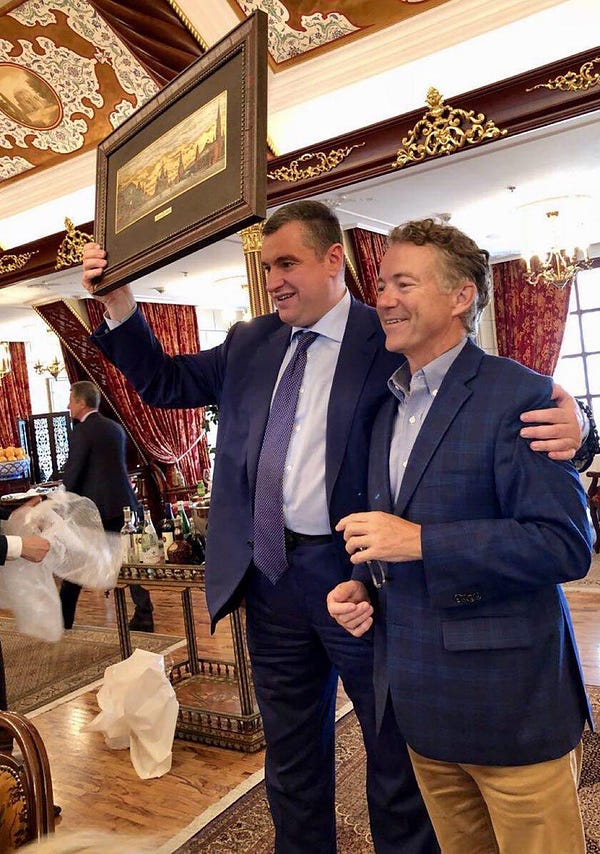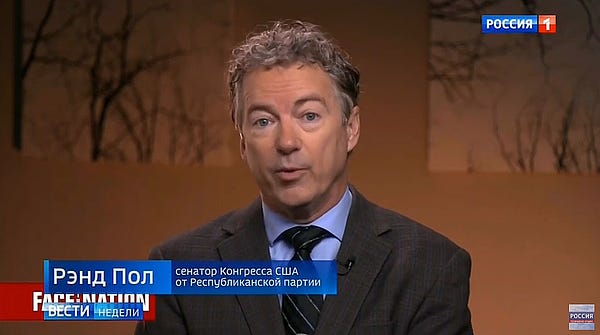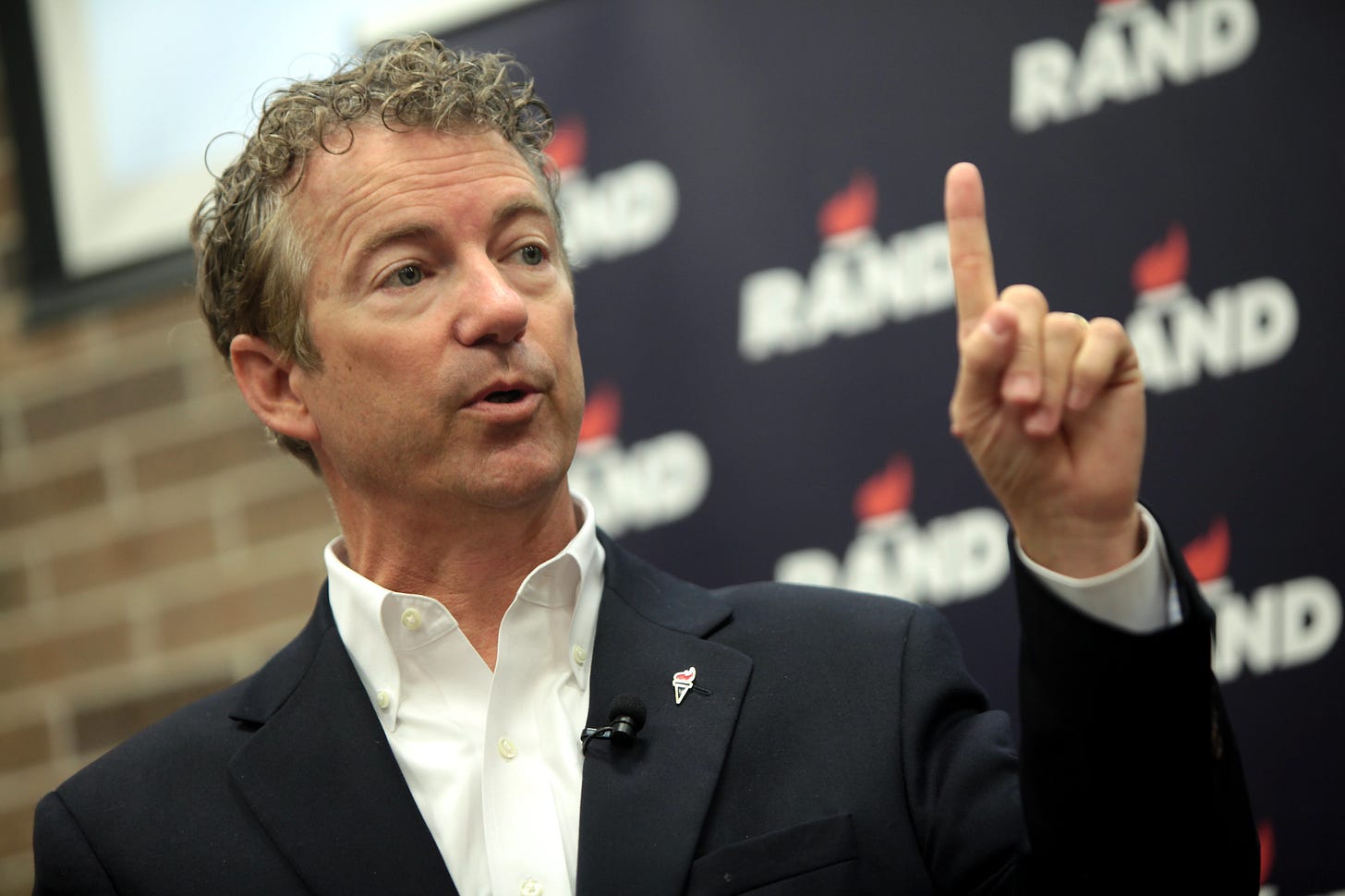Eight Ways Rand Paul is a Kremlin Stooge
"The senator from Kentucky is now working for Vladimir Putin," John McCain said. Take him at his word.
Randal Howard “Rand” Paul, the only sitting member of Congress to be beaten up by his next-door neighbor, made headlines last week for blocking U.S. aid to Ukraine. “Congress is trying yet again to ram through a spending bill—one that I doubt anyone has actually read,” he tweeted, “and there’s no oversight included into how the money is being spent.”
This sounds perfectly reasonable, an elected official safeguarding our taxpayer money. But as usual, Paul’s hardline libertarian orthodoxy is just an ideological cover for helping Vladimir Putin. That’s who benefits from Paul holding up the aid package. Not the American people. Not our Ukrainian allies. The Russian dictator and his raping, pillaging occupying forces.
It’s not like this is a one-time thing. Time and time again, Rand Paul has furthered the aims of our enemies in Moscow. He did this when he lobbied for sanctions to be lifted on Russian nationals close to Putin. He did this when defending Putin’s heinous military actions in Syria. He did this when voting against Montenegro joining NATO. He did this during Trump’s first impeachment. It’s kind of his jam.



When we look at his behavior over the years, the pattern becomes obvious. Whether he’s a full-on Russian asset or just a useful idiot—and he is definitely stupid enough to be the latter—the junior Senator from Kentucky is, in the words of his late Republican colleague John McCain, “working for Vladimir Putin.”
Here are eight ways we can tell that Rand Paul is a Kremlin stooge:
8. It’s a Family Affair
If Rand Paul’s casual defense of Putin regarding Russia’s illegal invasion of Ukraine seems familiar, it’s because Old Man Paul, “Libertarian” darling Ron, spewed much the same Kremlin-infused horseshit when Putin’s orcs annexed the Crimea in 2014.
“Crimea is not exactly a foreign country, according to the Russians. But I’m neutral on that,” Ron Paul said in February 2015. “I don’t take a pro-Russian stand. I don’t defend what they do. . . .I’m not pro-Putin, I’m not pro-Russian. I’m pro-facts.”
Pro tip: If you feel the need to qualify your public statements by saying that you’re not pro-Putin, you’re pro-Putin. And in case there was some ambiguity, Ron Paul made these statements at something called the International Students for Liberty Conference—immediately after traitor to his country and current Russian resident Edward Snowden.
Speaking of which. . .
7/ Doxxing a Real Whistleblower, Championing a Fake One
Rand Paul holds the dubious distinction of being the only GOP senator to be thwarted during the first impeachment trial of Donald John Trump. Because Paul’s submitted question included the name of the alleged whistleblower—who was, after all, the prime mover of the entire process—Chief Justice John Roberts refused to read it. A pouting Paul immediately left the chambers, in violation of the rules for the trial, and announced the name to the press. A few days later, during his seditious Senate speech, he stood in front of a placard bearing the alleged whistleblower’s name.
There is some question as to whether it is actually illegal to “doxx” a whistleblower. And, as the former federal prosecutor Renato Mariotti explained, “Rand Paul is doing this because the Speech or Debate clause of the Constitution shields him from liability for his speech on the Senate floor.” In other words, if he says it on the floor of the Senate, he can’t be sued for defamation.
But there is no question that Paul’s actions were intended as retribution. He seemed dead-set on putting the whistleblower in harm’s way. Given that Paul not that long ago was one of the few Republicans to defend Edward Snowden, the self-styled whistleblower and bona fide traitor, this is particularly rich.
But then, unlike the anonymous government employee who exposed Trump’s attempted extortion of Ukrainian President Zelenskyy, Ed Snowden is not an actual whistleblower. To the contrary, he is a tool of the Russians—you know, like Rand Paul.
(If you are still on the “Snowden is a hero” train, please consider that he is now in Russia and has barely tweeted since Putin invaded Ukraine—you know, because he’s such a brave champion of freedom.)
6/ Russian TV Star
Rand Paul is a mainstay of Russian state media, the garbage propaganda fed to the citizenry there. This clip shared by Julia Davis of the senator spewing Kremlin talking points is over three years old, but remains a representative example:


Even when Paul doesn’t appear, he is talked about:


A data scientist could probably quantify the level of traitorousness by analyzing how often and in what context U.S. politicians and media figures appear on Russian state television. Rand Paul has been a familiar face on TV there for so long that he’s basically the Russian Ryan Seacrest.
5/ The 180 on Trump
Once upon a time, Rand Paul was vociferously opposed to Donald John Trump, likening him to a singularly loathsome and pathetic J.R.R. Tolkien character: “I have compared him to Gollum from Lord of the Rings,” he quipped on Comedy Central’s “The Nightly Show.” On the same broadcast, Paul denounced Trump as “a delusional narcissist and an orange-faced windbag,” citing his similarities to Hitler and Goebbels.
Gollum is a hideous, friendless creature who cares only for his precious ring and will allow the world to destroy itself to protect it—Trump to a “T.” And the Defeated Former Guy is indeed delusional, narcissistic, orange-faced, and a windbag, and does indeed share similarities to Hitler and Goebbels.
Paul made these comments on 25 January 2016. At the time, he was still running for president. During the interminable slate of GOP debates, in fact, he’d distinguished himself as the candidate most opposed to Trump. Strange as it now seems, there were moments during that primary season when Paul was actually—gasp—likeable.
But after suspending his campaign a few weeks later, Rand Paul suddenly changed tack. On 1 April 2016, he told the Cincinnati Enquirer that while he would not endorse any candidate in the Republican primary, he would vote for Trump in November. “I’m from Kentucky,” Paul said, “and Hillary Clinton recently said she would put coal miners out of business, and she would put coal companies out of business.” This bit of cynical, Susan Collinsish pandering is both untrue and a foolhardy reason for entrusting the nuclear launch codes to a Hitlerian narcissist.
Once Trump won, Paul’s 180 was complete. Turns out, the politician most like Gollum was not Trump but Rand Paul: small, obsequious, pathetic, doing everything in his power to safeguard his precioussss, the Kremlin-friendly MAGA King.
4/ Helsinki
Rand Paul was one of few politicians who defended Trump after his disastrous showing in Helsinki, when the former reality TV star all but publicly fellated the Russian dictator. It’s easy to forget, in the swirling maelstrom of shit that was 45’s presidency, but Helsinki was the all-time most embarrassing showing on the world stage for an American president. (George W. Bush having the shoe thrown at him is a distant second. Dubya at least ducked; Trump stooped—literally and figuratively.)
Yet there was the Kremlin lapdog Rand Paul, extoling Trump’s performance. Not only that, he joined Trump in seeking the revocation of John O. Brennan’s security clearance after the former CIA director rightly denounced the Helsinki summit as “nothing short of treasonous.”
3/ Simes, Sealed, Delivered
Rand Paul served as a Trump/Russia intermediary, on one occasion flying to Moscow to deliver a handwritten letter from the president to Putin.
“The letter emphasized the importance of further engagement in various areas including countering terrorism, enhancing legislative dialogue and resuming cultural exchanges,” Paul said, as if Trump were capable of such nuanced statesmanship.
As Ariel Cohen pointed out at the American Interest, the hapless Paul botched even this simple courier job:
The White House was furious with the Senator going off the script and implying that [Rand Paul] had carried a confidential message from Trump to Putin. A fuming senior U.S. administration official told me that the Senator wrote the letter himself and that he insisted that U.S. Embassy personnel not accompany him to his meetings with Russian officials. This follows a pattern established by Trump in Helsinki in July, where only a translator was present at his two-hour-long meeting with Putin.
Wherefore all of this secrecy and frantic dissembling?
Rand Paul arrived in Moscow on 6 August 2018. His stated reason for making the trip: engagement. “The world is a complicated place, we are in close proximity to Russia in Syria and other places, and I think it would be a very big mistake not to have open lines of communication,” he said — preposterously, given the cozy relationship between Trump and Putin.
Even at the time, the stated mission strained credulity. Here is the lead paragraph of Ariel Cohen’s aforementioned piece in the American Interest:
As the sanctions war between the United States and Russia escalates, Senator Rand Paul (R-KY) has embarked on a bizarre mission to pull U.S.-Russian relations out of the tailspin caused by Russia’s aggression in Ukraine, intervention in U.S. elections, cyberattacks on the U.S. energy infrastructure, and alleged use of nerve agents in the United Kingdom.
None of this deterred Rand Paul. “Engagement,” he explained, “is vital to our national security and peace around the world.” It was in service to “engagement,” in fact, that the trip was paid for by the Cato Institute, the “libertarian” think tank underwritten by the odious Koch network.
This emphasis on engagement echoes the words of the Soviet-born U.S. lobbyist and longtime Nixon chum Dimitri Simes, former head of a Washington think tank and publisher of a periodical, the National Interest, that trumpets pro-Putin views. For many years, Simes was (allegedly) one of the highest-ranking Russian intelligence operatives in the United States. “Russia has a lot of nukes,” Simes often advised, “so it’s better to be friends than enemies. Engagement is key.” That Paul and Simes share this opinion of “engagement” makes perfect sense, as the two have been associates for years.
Another Simes BFF is Richard Burt, a Reagan-era State Department official with long ties to Russia. Burt, who sat on the Russian Alfa Bank advisory board (Alfa = Alpha = Semion Mogilevich)—was allegedly a key player in the changing of the Republican party’s platform to soften the party’s stance on Ukraine.
But the most notorious of Simes’ associates is the soi-disant “founding chairman [of] The Right To Bear Arms, a Russian version of the NRA”—one Maria Butina. Simes published her pro-Trump/pro-Russia screed “The Bear and the Elephant” in the National Interest in 2015.
Soon after Butina’s indictment—and subsequent to sitting for a long interview with the Office of the Special Counsel, detailed at length in the Mueller Report—Simes fled the United States for Russia, to co-host a Putin propagandist game show about how Russia will defeat the West.
2/ The Kosachev Connection
I don’t know if Rand Paul met with his pal Dimitri Simes during his summer 2018 Moscow adventure. But the Russians he did meet with should raise eyebrows. He engaged in talks with Sergei Kislyak, the multi-chinned former Russian ambassador to the United States — the same Sergei Kislyak who in 2016 held illicit meetings with numerous members of the Trump campaign and its associates, and who was photographed by the Russian press guffawing with Trump in the Oval Office. What sort of “engagement” did Paul seek from Kislyak?
Moscow’s point person for the meeting was Konstantin Kosachev, a senator at the Federation Council—Russia’s Senate—and the chair of its Foreign Affairs Committee. Kosachev is a staunch ally of Vladimir Putin, and was among the Russian politicians placed on the US sanctions list of 6 April 2018.
There was plenty of bonhomie between Paul and Kosachev. Here is the RT write-up of the meeting—in other words, the Putin-approved version:
Kosachev said that while no plans have been finalized, “certain specific subjects in the development of this co-operation” had been addressed during Paul’s visit, adding that he hoped a meeting between the Senate and the Federation Council Committee on International Affairs could be held before the end of the year….
The Kentucky senator has been an outspoken proponent for engagement with Moscow who voiced support for Donald Trump’s decision to meet with Russian President Vladimir Putin in Helsinki last month. Paul said last week that his goal in coming to Moscow was to find “common ground with [Russian] leaders and help prevent further, unnecessary escalation of tensions.”
What do you know! “Engagement” again!
When he returned from Moscow, Paul immediately went golfing with Trump, reportedly lobbying the president to allow Kosachev and other sanctioned Russian politicians to visit the United States. Even in this modest task, Paul failed. The visits did not take place.
This is welcome news, because Kosachev is not a new character in the Trump/Russia story. In his intelligence report of 20 October 2016, Christopher Steele, the former MI6 Moscow bureau chief, wrote about a meeting in Prague between Trump personal attorney Michael Cohen and his Russian counterparts that allegedly took place in late August or early September of 2016. The purpose of that meeting, Steele reported, was to “clean up the mess left behind by Western media revelations” of Russian ties to Paul Manafort and Carter Page.
The Putin surrogate who Steele reported was responsible for the coordination of this meeting was, at the time, the head of Rossotrudnichestvo, a Russian organization involved with foreign aid, with offices in major cities around the world, Prague included. His name? Konstantin Kosachev.
Yes: that Konstantin Kosachev.
Michael Cohen has repeatedly and steadfastly denied visiting Prague at this time, and insists the meeting never took place. Even so, the Putin surrogate who was rumored to have set up a key meeting between Trump’s people and the Russians in 2016—a big macher in Moscow, in other words—is the same guy Rand Paul met with in Russia two years later.
What did they discuss? What was really in that letter? Why was Paul so eager to have him visit the United States? When and where did Paul and Kosachev meet previously?
1/ John McCain Fingers Him as a Traitor
The recent revelations by Steve Schmidt, who worked on John McCain’s presidential campaign in 2008, make clear that Russia’s infiltration of the GOP long pre-dates Donald Trump. He writes:
Senator John McCain turned a blind eye to the dealings of his top adviser, Rick Davis, who was making millions of dollars with his partner, Paul Manafort. Manafort was advancing the interests of the Russian Federation in Ukraine and across Eastern Europe. They worked for the Putin puppet Victor Yanukovych and Russian oligarch Oleg Deripaska. They advanced Russian interests from the Maidan to Montenegro. John McCain spent his 70th birthday with Oleg Deripaska and Rick Davis on a Russian yacht at anchor in Montenegro.
It was Rick Davis who picked Sarah Palin to be McCain’s running mate—just as, eight years later, Manafort would choose Mike Pence to be Trump’s.
My take on this is that the Russians recognized McCain as a threat to their national security, and made a concerted effort to dirty up his reputation. Hence, his blowing out birthday candles with Oleg the Oligarch. (The Kremlin would similarly attempt to dirty up Joe Biden; I believe the Russians finagled the job on the board of Burisma for the troubled Hunter Biden so they would have something to hit Joe with later on, should the need arise.)
But the war hero who spent all those years in a Vietnamese POW camp is not going to betray his country at age 70 to start working for the Russians. This was clear to Steele, who set about trying to deliver his intelligence reports directly to McCain.
Schmidt’s revelations provide good background to the kerfuffle on the floor of the Senate in March of 2017. Parroting a Kremlin position, Rand Paul objected to a treaty to allow Montenegro into NATO, and John McCain—perhaps recalling with chagrin his birthday party in that country—accused him of “working for Vladimir Putin.”
This quote got a lot of play in the political press, who love that sort of thing, but the consensus seemed to be that McCain was using hyperbolic language to make his point. Also, because he said it on the floor of the Senate, McCain couldn’t be sued for defamation.
Even so: McCain explicitly accused Rand Paul, a senator from his own party, of working for Putin! On the floor of the Senate! That’s, um, not normal. Let me say it one more time: McCain explicitly accused Rand Paul, a senator from his own party, of working for Putin! I submit that when John McCain fingered Paul as a Russian stooge, he meant it—literally.
When it comes to Rand Paul being a traitor, don’t take my word for it; take McCain’s: “The senator from Kentucky is now working for Vladimir Putin.”
Photo credit: Gage Skidmore. U.S. Senator Rand Paul speaking with supporters at a meet and greet at Morningside College in Sioux City, Iowa, 2015.
NOTE: Some of this piece is culled from previous pieces I’ve written about Rand Paul.





Finally, journalism that does its job. What is it about those Kentucky senators?
“It’s easy to forget, in the swirling maelstrom of shit that was 45’s presidency, but Helsinki was the all-time most embarrassing showing on the world stage for an American president.”
No, it is not easy to forget. That Helsinki meet-and-greet is a hideous low point in Presidential history. All-time worst. 🤮